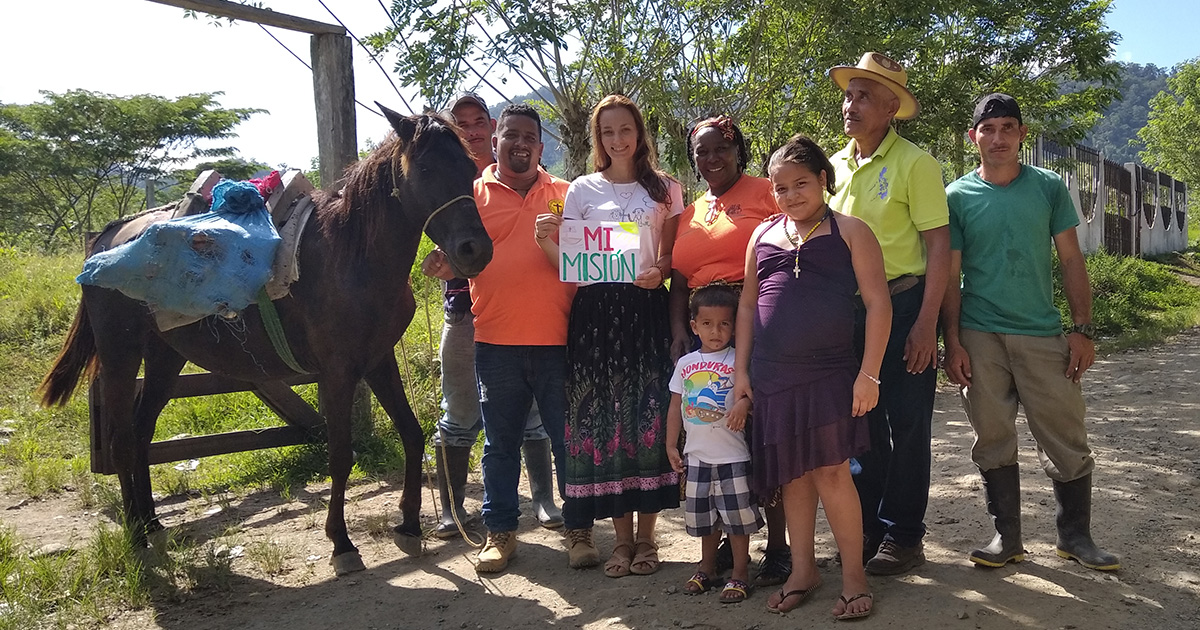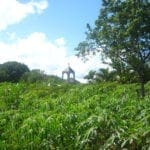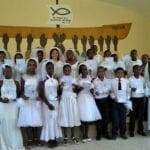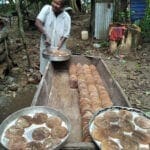“Go into the whole world and proclaim the gospel to every creature.“
For me, those words of Jesus were a spark that ignited the call of my missionary longing. What greater meaning can there be than to follow the words of the Eternal Truth? What can be more important than to proclaim eternal life and wisdom, to leave everything in order to go with Jesus to the ends of the earth in order to discover the face of Jesus on the face of those men and women who are poor, to go with Jesus and to know the people in their country, in their natural setting, in their cultural environment, to minister with Jesus, to extend the kingdom, to ennoble and make fruitful the Lord’s vineyard.
I have come to give and yet I have received much more. That concept, which I have found expressed in many articles about the missions, has always aroused my curiosity and surprise. I wanted to discover this universal call, a call that at times is hidden and yet it is also a call that convokes everyone to be a missionary. It is God who is going to give and to teach because as God spoke through the prophet Isaiah: my thoughts are not your thoughts, nor are your ways my ways (Isaiah 55:8). God’s logic is different than ours. Our yes is sufficient for God to lead us on high even though the path may at times be covered with thorns. Nevertheless, at the end of the path, the Good Shepherd will come and heal our wounds … God gives one hundred times more than we ever expected.
I made a firm decision to go on the mission. I simply had to respond to the questions: when, where and with what organization. Many missionaries want to go to Africa and that was also my desire even though I was also attracted to missionary work among the indigenous peoples of Central and South America. During my time at the University, Father Noga gave a presentation on MISEVI at the pastoral center. I was captivated by the thinking of MISEVI: to be a missionary for the whole of one’s life; to respond to the missionary call by serving in Honduras. After some years, as this idea matured in me, I made contact with MISEVI and spoke about my desire to go to Honduras. After receiving the necessary formation in Slovakia and language preparation in Spain, I, together with my friends Janka and Ingrid, arrived in Honduras in August 2019.
The first thing that one notices about Honduras is the heat. Then one also begins to discover the natural beauty that God has given to Honduras. As time moves forward, one also discovers more and more of its secrets and beauty. The admirable and imposing trees that are found both inside and outside the jungle areas; beautiful, colorful flowers; singing birds; horses that freely graze; cattle fields; the night skies illuminated with countless stars … then one also comes to know the inhabitants of this country, those men and women that one hopes to know and to whom one hopes to proclaim the Good News.
Our “home base” was in Sangrelaya, where the Slovakian priests of the Congregation of the Mission have a pastoral center and a parish house. We began to establish relationships with the people of this area after the celebration of the Eucharist and during our visits to their homes. We had to accustom ourselves to speaking and listening to others speak in Spanish. We also began to visit the school and gave catechetical lessons to the children (religion is not taught in the Honduran schools). Janka is a nurse and she ministered in the dispensary with one of the religious Sisters.
After having established some relationships with the people, we set out to engage in our first popular mission in the area of Batalla (composed of four communities). We visited the homes of the people and with them, we reflected on the Word of God. We prayed together with them and asked that God would bless them. We also invited the people to participate in formation sessions. In this way we attempted to strengthen the faith of the people and thus compensate for the absence of a priest in that area (the priests have many communities where they are ministering and there is not enough time to visit all these communities on a regular basis).
Another aspect of our mission was to enter into the culture and the life of these people. Sangrelaya and the majority of the other communities of this parish are inhabited by Garifunas (people from Africa who came to the island of St. Vincent during the seventeenth century and to Honduras in the eighteenth century). The Garifunas have preserved their cultural identity through their colorful clothing, dance, music and food.
Another aspect of the life in this area is the great number of insects. One’s skin will often reveal the bite marks of mosquitoes, flies, ants and other insects. Janka suffering greatly from these bites. She was hospitalized for five days (her face had become infected and inflamed and she received strong antibiotics). There are also spiders, and cockroaches and scorpions. When showering one uses a bucket or goes to the beach. It not advisable to drink the running water (those not accustomed to this water can develop intestinal problems).
Although the Garifunas are predominant in Sangrelaya, yet in Honduras they make up a small percentage of the population. Another group of the inhabitants is known as the Misquitos who live in the most distant community in the parish (in Ibans, on the shores of the sea and the lagoon). These people are very reserved and almost all the members of this group are members of a Protestant Church (especially the Moravian Church). These people, however, seemed to be interested in some Catholic devotions, for example, the use of holy water and the miraculous medal which was distributed in large numbers. The Catholic community in Ibans is composed of seven families. Since the priest celebrates the Eucharist once a month or once every two months, it is not surprising that so many of the inhabitants participate in Protestant services … people do not make a distinction between the Catholic and Protestant churches and many of them do not know the meaning of the Eucharist. Thus, people will go to the church where they know the pastor who lives in the same town. Many of the children do not know how to make the sign of the cross (it would be wonderful if a priest were able to reside in this community and thus able to serve the people on a regular basis).
The community of Planes, another indigenous community, is served by three zealous Delegates of the Word. In addition to the Sunday liturgy, these ministers conduct holy hours, prayer meetings, and catechize the children.
In addition to the popular missions, we also participated in formation sessions for the parishioners, a youth song festival, gatherings of the Vincentian Family, and gatherings of religious ministers.
We were also able to visit the men’s prison where we accompanied the priest who celebrated the Eucharist for the prisoners. We were able to distribute to the prisoners some packets of personal hygiene items that had been donated by the parishioners. The prisoners provided the music for the Eucharistic celebration. During the celebration I was seated in from of a young man with whom I spoke at the conclusion of the celebration. Unfortunately, he had become involved in drug trafficking (which is quite widespread throughout Honduras). He did not have a long prison sentence but one of the consequences of his behavior was to be locked up for several years in terrible conditions. It was clear, however, that this man wanted to change his life and so while in prison he was learning carpentry which would provide him with a trade when he left prison. Before leaving the prison, I gave this young man a keychain of the Miraculous Medal (a Sister from the Czech Republic had given this to me as a gift) and I will never forget his look of surprise and excitement.
On Mission Sunday I accompanied some parishioners as they went to the neighboring parish in Sico … and so there we were a Garifuna, an indigenous woman and myself (a woman from Slovakia) proclaiming the good news to another indigenous group, the Ladinos.
I will always remember the spontaneous encounters that consoled and distracted me during some difficult moments. One of those encounters took place with a nine-year old boy, Carlitos. We spoke together while at the beach and his deep gaze and large dark eyes will always remain a vivid memory. I would hope that he remember the heart of Jesus that I drew in the sand that evening. The heart of Jesus and his mercy are especially dear to me and during the time of the mission I attempted to promote this devotion.
I used my free time to ride through the countryside on horseback, to go swimming in the ocean or canoeing on the river. I often prayed the rosary beneath a large cross that is in the center of the courtyard of the parish house.
This time in Honduras taught us to live in accord with a pastoral plan but also to be able to change plans in accord with the situation. Honduras is said to be the second most dangerous country in the world and we experienced that reality (a small plane, transporting drugs, crashed in the middle of our town; we experienced murders and rapes and buried small children who had been bitten by snakes). While all of this was happening around us, we were never directly in danger. God provided for us and we met countless kind, good and generous people who were always willing to help us.
Thanks to their open hearts and their trust in divine providence, I will always be able to return to Honduras … perhaps one of the most dangerous countries in the world, but also a most scenic country populated by people whom I call my friends, a country to which God led me so that I could learn anew that God is my best and most faithful companion on the journey of life.
Men and women cannot remain seated with their arms crossed. The Kingdom of God is like the vast sea – the nets must be cast. It is like the priceless pearl – but we have to find it. The Kingdom of God is like hidden treasure – but we have to excavate it (Santo Tomas de Aquinas).
Anastazia Hamadejová















0 Comments